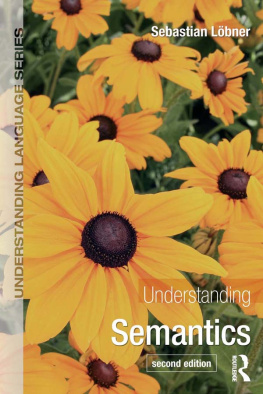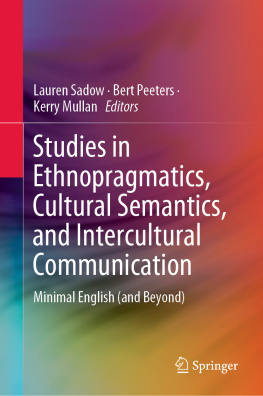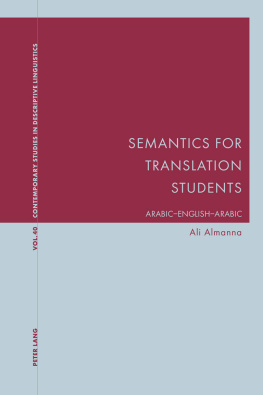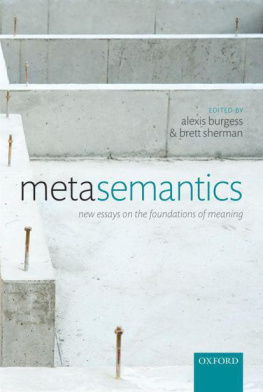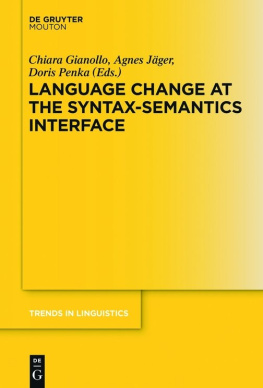2022 Massachusetts Institute of Technology
All rights reserved. No part of this book may be reproduced in any form by any electronic or mechanical means (including photocopying, recording, or information storage and retrieval) without permission in writing from the publisher.
This book was set in 10 on 13 pt Times by New Best-set Typesetters Ltd.
Library of Congress Cataloging-in-Publication Data
Names: Larson, Richard K., author. | Ryokai, Kimiko, illustrator. | Nash, Stephen, illustrator.
Title: Semantics as science / Richard K. Larson; illustrated by Kimiko Ryokai and Stephen Nash.
Description: Cambridge : The MIT Press, 2021. | Includes bibliographical references and index.
Identifiers: LCCN 2021000769 | ISBN 9780262539951 (paperback)
Subjects: LCSH: Semantics.
Classification: LCC P325 .L2985 2021 | DDC 401/.43dc23
LC record available at https://lccn.loc.gov/2021000769
10987654321
d_r0
To Wayne ONeil (19312020)

Photo by Stan Honda.Reprinted with permission.
Contents
Preface for Teachers
Like its companion volume Grammar as Science (GAS), this book arose out of an effort to rethink part of the undergraduate linguistics curriculum at Stony Brook University in line with the traditional goals of undergraduate education, which emphasize liberal arts values over pre-professional training. Specifically, Semantics as Science (SAS) considers the structure and content of introductory linguistic semantics from the standpoint of three broad questions:
- What is the general educational value of studying semantics, including value to students who do not intend to pursue graduate studies in linguistics, and who may not be majoring in the subject?
- What broad intellectual issues are engaged in studying semantics?
- What general intellectual skills are developed by studying semantics?
The answers embodied in this book overlap some of those for studying syntax and are embodied in GAS as well:
- The subject matter offers an excellent means for introducing students from a wide variety of backgrounds to the principles of scientific theorizing and the process of systematic theory construction.
- The subject matter engages both the general intellectual issues present in all scientific theorizing and specific issues arising within modern cognitive science and analytic philosophy. For example:
- How does a scientist construct, test, evaluate, and refine a theory?
- How does a scientist choose between alternative theories?
- Can one study a human phenomenon as a natural object and gain scientific understanding of it?
However, semantics possesses another virtue not as readily developed in a typical syntax course:
- It offers an excellent medium through which to acquaint students with the notion of a formal, axiomatic system, that is, a system that derives results from a precisely articulated set of assumptions according to precisely articulated rules.
Formal systems lie at the core of logic and computer science, and underlie all of modern digital consumer technology. They are also the basis for one of the most widely held views of human mental function: the computational theory of mind.
This book is intended both for undergraduates who are majoring in linguistics and for undergraduates who are taking linguistics courses through a department of linguistics but do not plan to become majors. It assumes a basic familiarity with tree diagrams for syntactic structure at the level of a standard introductory linguistics course, but nothing more.
The focus of SAS, coupled with its intended audience, has dictated a number of its main features.
Formalism
If the basic questions of semantics are to be approached through construction of an explicit deductive theory, then students will require formal tools and some training in how to use them. At the same time, if the intended audience is nonspecialists, with no background in formal study per se (and possibly even an aversion to it), then the tool set should be minimalist in spirit and as easy to master as possible, without extensive skill building.
SAS develops semantic theory through the device of axiomatic T-theories, introduced by Alfred Tarski over eighty years ago. However, the version it develops is one that minimizes appeal to the technical apparatus that today constitutes the Latin of academic scholarship in semantics. A key difference lies in the way semantic valuation is handled.
Standard model theory treats interpretation/valuation as a function ( ) mapping syntactic objects (expressions) to objects in a model. Because functions must yield a single value for a given input, the only reasonable candidate denotations for predicates in an extensional theory are functions of the familiar kind (iac):
| (i) | a. | [V smokes] | = | x[smokes(x)] |
| b. | [V admires] | = | yx[admires(y)(x)] |
| c. | [V gives] | = | zyx[gives(z)(y)(x)] |
| And so on. |
This requires the teacher to introduce, from the very start, elements such as functions, a composition operation of function-argument application, and lambda conversion.
But as the logician George Boolos pointed out, all this is simply traditional and not forced upon us. If we treat interpretation/valuation, not as a function, but as a relation (Val), the machinery of functions can be largely dispensed with and the metalanguage made considerably simpler:
| (ii) | a. | Val(x, [V smokes]) | iff | x smokes |
| b. | Val(<x,y>, [V admires]) | iff | x admires y |
| c. | Val(<x,y,z>, [V gives]) | iff | x gives y to z |
| And so on. |
Composition becomes substitution of identicals, which standard theories need in any case.
I have found relational interpretation very easy to convey to students. Here, we say that the predicate smokes is true of an individual x just in case x smokes. In the standard approach, we must say something like, The predicate smokes is true of an individual x just in case the function that smokes denotes yields the value true (or 1) when applied to x. Yes, we can convince students that saying the more complicated thing amounts to saying the simpler thing. But I have found it easier to say the simpler thing in the first place. Technical elaboration of the metalanguage does become necessary at later points; for example, set theory enters into the treatment of quantifiers. But under the minimalist approach adopted here, I introduce it at the point where it is required for expressive purposes, not as an artifact of .
Finally, in my experience the technical apparatus of SAS poses no problems either for beginning students or for those who wish to pursue semantics at a more advanced level later. The former have no prior notions about semantic valuation, and the latter transition easily from




